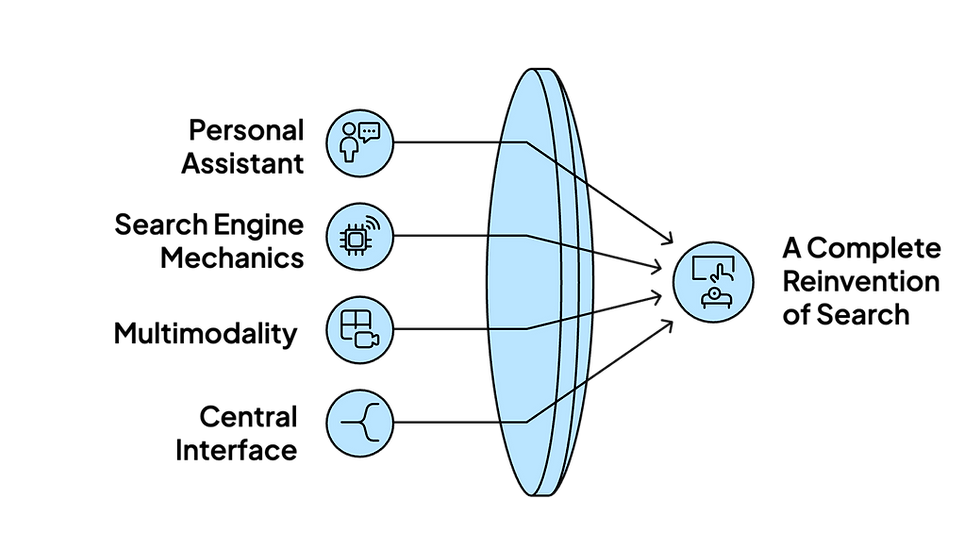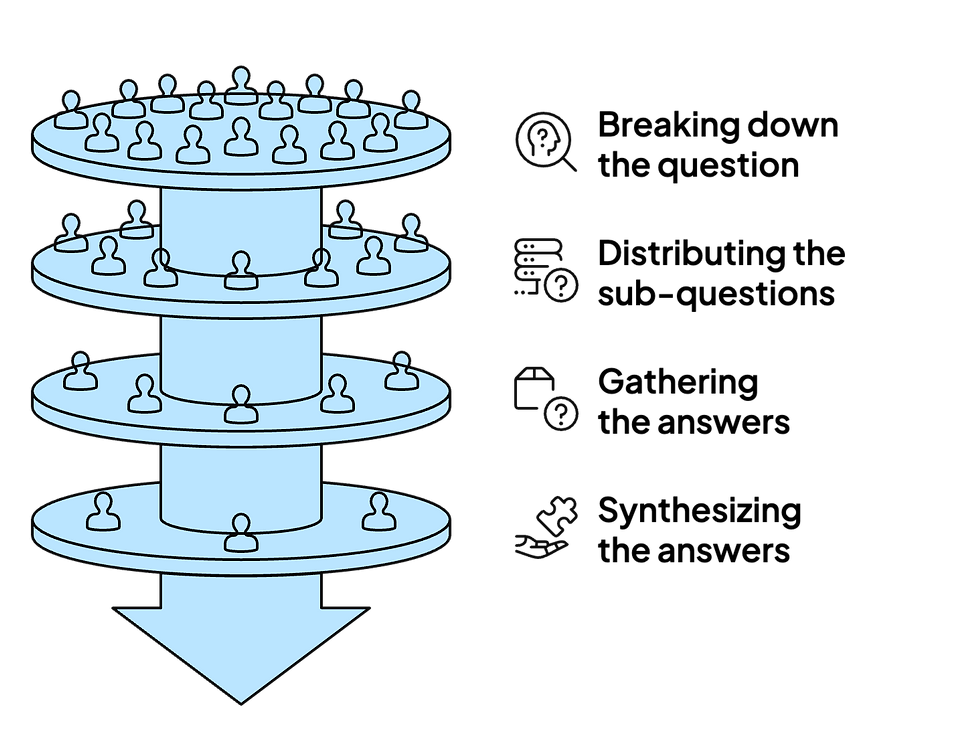Google’s AI Mode: GEO Strategy Guide for the New Search Era
- Clément Schneider

- Aug 6
- 5 min read
Updated: 20 hours ago
The search industry isn’t just evolving—it’s undergoing a seismic shift. Forget incremental tweaks or yet another feature update: Google’s AI Mode is not just the next generation of AI Overviews. It’s a radical reinvention.
We're witnessing a search engine transform into a smart, conversational, multimodal assistant—one that doesn’t just point to information, but delivers answers, choices, and even actions.
After launching in the US (mid-May 2025) and rolling out to the UK in June, full AI Mode is expected to arrive in Switzerland by late 2025 or early 2026, while France may not see it before 2026, mostly due to regulatory concerns.
Understanding this major disruption—and preparing for it—is not optional. It’s game-defining.

A Paradigm Shift Explained
Here’s what sets AI Mode apart from previous Google updates:
From query engine to dialogue assistant: Users can now ask follow-up questions, dig deeper, explore alternatives, and even complete transactions (buy, book, compare) directly in the AI interface.
Radical re-engineering of retrieval: Thanks to a method known as query fan-out, a user’s question is intelligently split into dozens of sub-queries, which enable Google to conduct parallel searches across its entire ecosystem (News, YouTube, Shopping, etc.).
Native multimodality: AI responses blend text, video, product data, and knowledge graphs—resulting in highly personalized, high-fidelity answers, not just snippets.
No longer a feature—it’s the interface: AI Mode is quickly becoming the default experience for search, not a side component.
Search professionals are already reporting a drop in organic traffic of up to 60% in AI-enabled regions. Users get what they need before ever leaving Google. In this new game, visibility without clicks is power.

Introduction to the New Search Arena
Before you adapt, you need to understand the game-changer: generative search is not an update—it’s a system reboot.
How Google’s AI Mode Works: The “Query Fan-Out” Architecture
The signature innovation behind AI Mode is its query fan-out architecture:
Your single question = dozens of sub-questionsEvery search is decomposed into multiple specialized micro-queries.
Each task goes to a specialistThese micro-queries are simultaneously sent across Google Search, News, YouTube, Shopping, Reddit, and more.
Response tied together in < 500msMassive AI orchestration (powered by Gemini) compiles these answers into a single high-context response—light-years ahead of a basic SERP.
This approach is resource-intensive, but it creates conversation-ready, multimodal outputs users trust and prefer.

What Content Is at Risk—and What Has Upside?
Not all content fares equally under AI Mode:
At Risk: Basic informational content FAQs, "How to" guides, definition articles — AI now answers these in full. Users never need to click through. Welcome to the zero-click economy.
The Opportunity: Product and service content Business pages, product listings, and transactional pages can be boosted if they’re cited and linked in AI answers. When that happens, Google becomes your top prescriber. In some cases, traffic to these pages increases by 40%.
It’s a growing frustration. Here's why ranking well in traditional SEO is no longer enough:
Different ranking criteria Classic SEO qualifies you—but doesn’t guarantee selection. AI prefers structured, factual, and high-trust content.
Passage-based retrieval AI doesn’t see your full page; it sees parts. A paragraph on page 3 of a forum might beat your polished homepage.
Source bias AI systems have favorite content types. ChatGPT loves Wikipedia. Google loves Reddit for user perspectives. Unless your brand fits the narrative, you may be ignored—regardless of quality.
GEO: Generative Engine Optimization Playbook
You don’t abandon SEO—you evolve it. GEO is the missing layer designed for search powered by LLMs.
Content Strategy: Create What AI Can’t Summarize
To win visibility in generative search, offer original value AI can’t simply “paraphrase.”
Lived Experience (“E” in E-E-A-T)Publish real test results, case studies, or insights only you can provide as a practitioner.
Proprietary DataUnique surveys, first-party insights, and internal stats = exclusive content AI must cite.
Analytical ExpertiseOffer strategic opinions, not just summaries. If your content adds perspective, the model adds your name.
Technical Strategy: Speak AI’s Language with a Knowledge Graph
To gain trust from AI systems, implement a semantic Knowledge Graph using JSON-LD. It’s your site's technical résumé.
Define & connect your entitiesExplicitly tell AI who your company is (Organization), who your experts are (Person), and how they relate (this person authored this post for this org).
Use sameAs as a trust signalLink these entities to authoritative sources—Wikidata, Wikipedia, official social profiles. AI treats these as proof of legitimacy.
GEO vs SEO: Clear Distinction
SEO | GEO | |
Goal | Rank your web page | Be cited by the AI |
Target engine | Index / Search Results | Response Generator |
KPI | Click-throughs | Mentions, authority, visibility |

Want to act now? Our AI SEO agency helps businesses implement GEO strategies that match this new search reality.
Adapting to Survive: The New Search Economy
What happens when clicks are no longer the main currency?
New KPIs in the Age of Zero-Click Search
Forget classic rankings and pageviews. In AI-first search, here’s what matters:
Citation frequency — How often is your site/brand quoted in AI responses for strategic queries?
Share of Voice (SOV) — Compared to competitors, how prominent are you in AI-generated answers?
Tools in development — Platforms like SEMRush and SE Ranking are building tools to track this. But for now, combine those with manual checks to spot trends.
Monetization Without Clicks: How?
New distribution demands new business models.
Brands are already adapting:
Licensing content to LLMsMajor publishers are starting to monetize through licensing deals with OpenAI, Meta, Google, etc.
Built-in monetization toolsSearch tools like Perplexity now offer publisher partnerships. Bing Chat is testing ad revenue sharing.
Independent strategiesBrands without scale still have options:
Build direct audiences (newsletter signups driven by your mentions in AI)
Sell products/services (use verified AI authority as proof of quality)
Launch brand partnerships leveraging your expert reputation
Final Word: Will Google AI Replace SEO?
No. But it will force SEO to transform.
Repetitive, technical tasks like keyword mining and simple on-page optimization are becoming automated.
But AI cannot replace:
Strategy — Understanding user intent and brand positioning
Semantic architecture — Designing structured, machine-readable content
Creativity & empathy — Telling stories only humans can write
The SEO of tomorrow is not just a technician.They are a trust architect.A content strategist.A critical business partner who knows how to scale visibility—whether you’re dealing with humans or machines.

Clément Schneider is the founder of Schneider AI, a strategy consultant specializing in AI & marketing, and former CMO for Silicon Valley startups. A regular speaker at universities such as OMNES/INSEEC and CSTU, he helps organizations turn generative AI into measurable growth — blending innovation with business performance.


